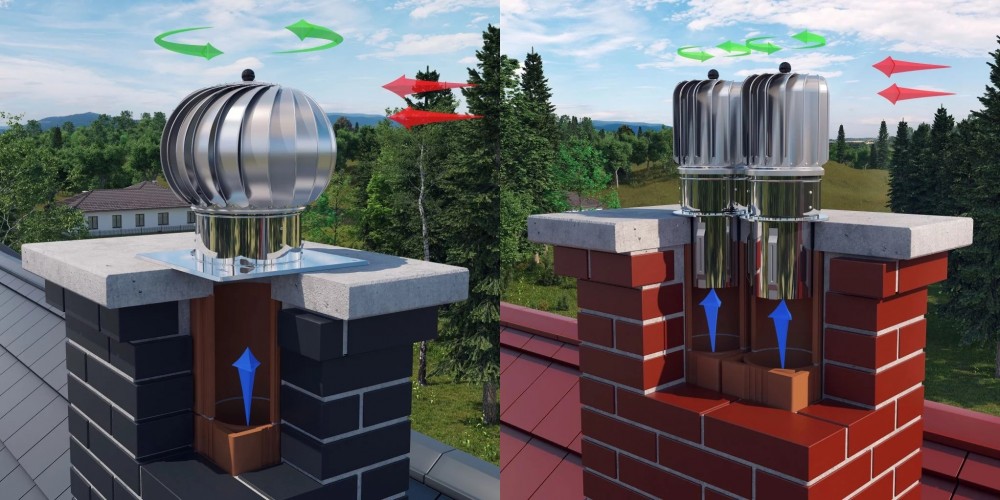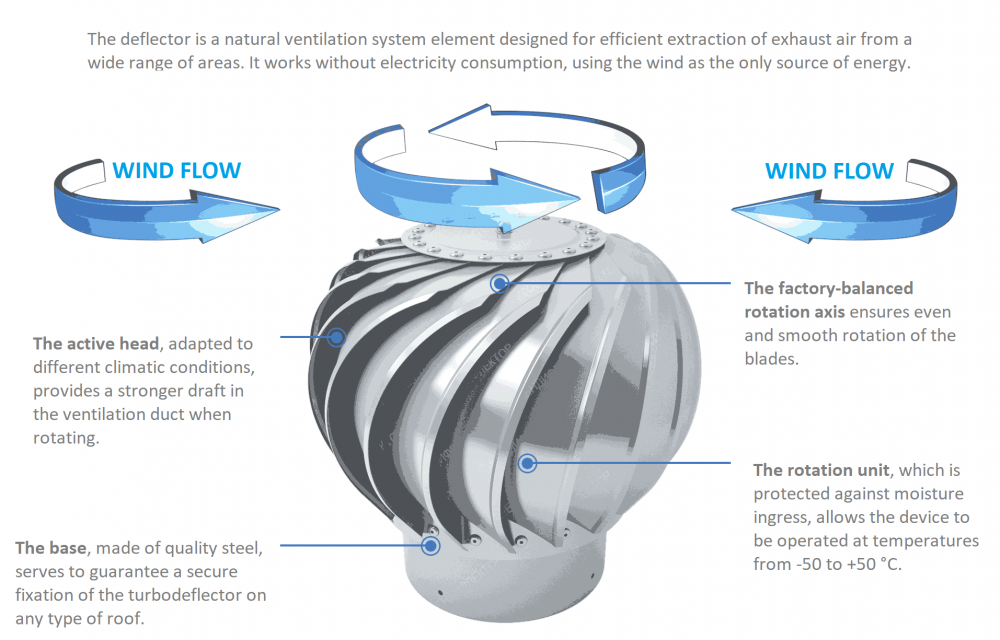| Cowls (Chimney and Ventilation)
What is a Deflector and Why is it Needed?

A deflector (also known as a cowl or terminal) is an aerodynamic device installed at the end of a ventilation duct or a chimney. Its main purpose is to use wind energy to create and enhance the natural draft in the channel, through which used air is removed from areas like bathrooms or from kitchen extractor hoods. Additionally, it serves an important protective function by preventing precipitation (rain, snow), debris, and birds from entering the system.
The key aspect to understand is that a deflector for a ventilation system and a deflector for a chimney are two fundamentally different devices. They are subject to different European standards and safety requirements. Using a ventilation deflector on a chimney is not permitted, and therefore making the right choice is a key aspect of ensuring the effective and safe operation of the entire system.
Operating Principle and Main Types of Deflectors
The operation of any deflector is based on Bernoulli's principle: as the airflow around the device's body accelerates, an area of lower pressure is created. This vacuum draws air or flue gases from the channel, enhancing the draft. Depending on their design, deflectors are divided into two main types.
| Characteristic |
Static Deflector |
Rotary Cowl (Turbo Deflector) |
| Operating Principle |
Creates draft through its special geometry as wind flows around it. |
Actively extracts air with a wind-driven rotating turbine. |
| Moving Parts |
None. |
Yes (a rotor on a bearing assembly). |
| Efficiency in Light Wind |
Low, directly dependent on wind speed. |
High, operates even in light winds (from 0.5 m/s). |
| Dependence on Wind Direction |
May be dependent (older models). |
Independent, works effectively in any wind direction. |

Key Differences, Standards, and Materials
The most important question when choosing is the application. Deflectors for ventilation and chimneys have fundamentally different designs, materials, and safety requirements because they operate in completely different conditions.
-
For Ventilation
Task: To enhance air exchange, remove excess moisture and odors.
- Operating Conditions: Normal room temperature air.
- Key Standard: EN 13141-1 (evaluates performance).
- Materials: Galvanized steel, aluminum, stainless steel.
-
For Chimneys
Task: To ensure a stable draft and guarantee fire safety.
- Operating Conditions: Hot, chemically aggressive flue gases.
- Key Standard: EN 1856-1/2 (evaluates safety and heat resistance).
- Materials: Only heat-resistant and acid-resistant stainless steel.
- Design: Often equipped with an external bearing, which is protected from heat and soot, ensuring long-term operation without seizing.
Basic Rules of Application
- Channel Separation: It is strictly prohibited to combine chimney and ventilation ducts. This is a fundamental safety rule.
- Standard Compliance: Ensure the chosen deflector is certified according to the standard appropriate for its application.
- Cross-Section Preservation: The deflector's design must not significantly constrict the pipe's outlet.
Conclusion: Safety and Efficiency as the Top Priority
Choosing a deflector is not just buying a "cap for a pipe," but a responsible engineering decision. A correctly chosen device will enhance your system's efficiency and last for many years, whereas a mistake in choice can lead to improper system performance and a reduced level of safety. Always check the intended application of the deflector.
Installation: From Components to Professional Service
Where to install? A deflector is mounted on the highest point of a vertical channel—at the end of a ventilation shaft or chimney located on the building's roof. Proper installation ensures its maximum effectiveness.
Everything for installation: For secure mounting on pipes of any cross-section (round, rectangular), we manufacture any necessary transitions and adapters. We will select or produce the components specifically for your system.
Professional installation: If you want to guarantee a perfect result, SIA "Akvilon" offers professional installation services. Our in-house specialists ensure the correct installation of all components, including deflectors, sealing of joints, and commissioning to guarantee the design efficiency and longevity of the entire system.

CE Certification and EU Compliance
All system components supplied by Akvilon are CE marked, confirming their full compliance with EU regulations, including the Ecodesign Directive (ErP) and the airtightness standard EN 12237.
Still have questions? You can find answers to frequently asked questions in our FAQ section.
Configuration and Design
Our engineers are ready to help you design and configure a ductwork system for your project, including the fabrication of custom parts and adapters from your drawings. You can also purchase all standard components in our online store.
| |
|
|